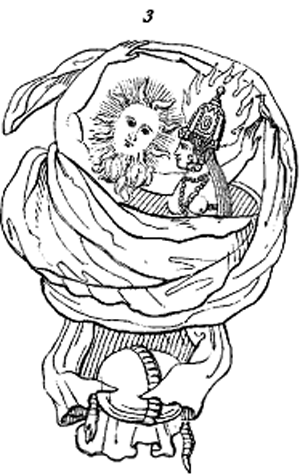

This figure represents the Mystic Brahma espousals with Parasakti. The latter is the divine principle of intellectual emanative potentiality or energy, and the ideal of archetypal womanhood. The Sakti is conceived of as the female part of the energy of Brahma's intellectual, creative power and creative wisdom. Brahma is here the true Para-Brahma, and Para-Sakti a true Para-sarasvadi. The sexless in Brahman (neuter) is here transmuted into the male or energizing power, as the principal symbolic type of the divine emanative, yet immanent, creative power, as the masculine principle of the ideal or Great Androgynic Man or the Makrokosm; and the flaming Sun is here depicted as the flaming sun-face, representative of the male-active deity, also called Purusha. The Sakti or Para-Sakti, the fructifying energy and potentiality of Brahman's wisdom, wears upon her head a bright fire-flaming crown or nimbus.
The veil surrounding them, is the mystic veil produced by the ideation of the eternal thought of the eternal Mind. In the left hand of the sun-figure on the first finger, is carried a bird or perhaps a dove, which is intended to symbolize the flight of the ideal creation from the eternal Mind before the appearance of that which appears to us to be the real world. In the right hand he holds the end of the mystic veil. On the head of Maya — the woman — is the world-egg cap. Below, in the shadow of the spherical cloak of the God-dawn, is seen the world-egg surrounded by the spiritualizing Ananda the snake of eternity, which as if asleep and inactive, is suspended around the egg.
In India the principal general symbols are fire and water, sun and moon, man and woman, bull and cow, the linga and yoni, the lotus and the sacred fig (ficus indica). The lotus is formed of red, white and blue colors; blue is considered the same as black.